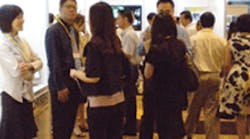Medical manufacturing: Easier to set up shop in Singapore?
Not long ago Merlin MD, a small start-up that makes stent-like devices for endovascular therapies and treatment of cerebral strokes, was looking for a place to locate. It didn’t even consider setting up shop in the United States, says President and COO Michael O’Connor. “Funding is extremely hard to obtain and government support schemes are complex,” he says. “Our choice came down to Switzerland or Singapore. We selected Singapore because government agencies there were ready, willing, and able to support us. For example, the Singapore Economic Development Board (EDB) provided a Research and Development grant and equity-based funding, the Standards, Productivity, and Innovation Board (Spring Singapore) gave us a Development grant, and International Enterprise (IE) Singapore helped introduce us to new markets such as Brazil and Mexico.”
The Singapore government has made it their mission to help small medical-device companies such as Merlin MD. Government agencies provide not just funding, but also top-notch R&D from their own researchers as well as from MIT and Harvard. The agencies also provide access to a ready-made global supply chain. Often referred to as “Asia Lite” or the “gateway to Asia,” the small nation (it covers an area slightly smaller than that of Manhattan) understands both Eastern and Western business practices. Companies there sell to and source from emerging countries such as Malaysia, Thailand, and Vietnam as well as traditional markets such as the U.S., China, Japan, and Australia.
The country provides many business advantages. Examples: English is the primary language; IP protection is strict and enforceable in court. Singapore’s airport is top-notch, the seaport is the best in Asia, and the workforce is highly skilled. Further, Singapore’s small size and lack of natural resources has made it expert at how to design with a collaborative, integrated approach, whether for a product or an entire nation.
There is no doubt Singapore’s government has its eye on medical technology. Another governmental organization, the Agency for Science, Technology, and Research (A*Star) has implemented medical-technology (MedTech) initiatives. These include the biomedical engineering program (BEP), a collaboration between A*Star and the Center for Integration of Medicine and Innovative Technology in Boston, Mass.
BEP is intended to help engineers and clinicians collaborate in developing and providing cost-effective innovative medical products through research projects. According to Program Director Dr. Tan Sze-Wee, the agency funds public-sector based research performers that locate in Singapore regardless of where on the globe they initially come from.
Local enterprises looking to diversify into medical-device manufacturing can take advantage of the MedTech Manufacturing Consortium, which helps firms develop their capabilities and technologies and train manpower. A small sampling of the many capabilities available through the consortium includes: precision forming; mass finishing of small medical components by abrasive flow machining; anodisation and polishing of surgical materials; and powder injection molding and laser microwelding of dissimilar materials.
Several innovative products have come out of A*Star. One example: a safety needle sheath. When the needle withdraws, the sheath, which is connected to the base of a syringe, returns to its extended position, covers the needle, and locks into place. Another product: a wearable robotic arm intended for post-stroke rehabilitation. The design comprises a biokinematic structure which mimics the seven degrees-of-freedom of the human arm.
According to the formerly Canadian-based company AB Sciex, EDB and IE helped ready the firm to start producing its mass spectrometers. The machines can break down the molecules of any compound to answer questions about its makeup and the best way to use this information. According to company personnel, site revenue jumped 20 times over the period from 2006 to 2009. Also, because Singapore once handled a lot of semiconductor manufacturing, existing workforce skills were easily transferred.
Contract manufacturer Meiban has also relied on the agencies. It now boasts 22 manufacturing facilities located in Singapore, China, and Malaysia. Company engineers have invented a special controller that connects to any existing standard injection molding machine and doubles its production. The device takes advantage of the cooling cycle to make a second part while the first is cooling. The technology may also be used to produce parts with a lower-tonnage, and thus less expensive, machine. It also ensures total part-color matching. Interestingly, company reps say the firm has never been in the red.
Sources:
Authored by: Leslie Gordon, Senior Editor
[email protected]
A*Star, a-star.edu.sg
AB Sciex, absciex.com
International Enterprise (IE) Singapore, iesingapore.gov.sg
Meiban, meiban.com; imt.com.sg
Merlin MD, merlinmd.com
Singapore Economic Development Board (EDB), edb.gov.sg
About the Author
Leslie Gordon
Leslie serves as Senior Editor - 5 years of service. M.S. Information Architecture and Knowledge Management, Kent State University. BA English, Cleveland State University.
Work Experience: Automation Operator, TRW Inc.; Associate Editor, American Machinist. Primary editor for CAD/CAM technology.
